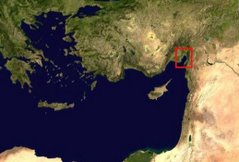In recent years, excavations in Israel established that the Philistines had fine pottery, handsome architecture and cosmopolitan tastes. If anything, they were more refined than the shepherds and farmers in the nearby hills, the Israelites, who slandered them in biblical chapter and verse and rendered their name a synonym for boorish, uncultured people.
Archaeologists have now found that not only were Philistines cultured, they were also literate when they arrived, presumably from the region of the Aegean Sea, and settled the coast of ancient Palestine around 1200 B. C.
At the ruins of a Philistine seaport at Ashkelon in Israel, excavators examined 19 ceramic pieces and determined that their painted inscriptions represent a form of writing. Some of the pots and storage jars were inscribed elsewhere, probably in Cyprus and Crete, and taken to Ashkelon by early settlers. Of special importance, one of the jars was made from local clay, meaning Philistine scribes were presumably at work in their new home.
Monday, March 26, 2007
Aegean Archaeology in the News
While Amanda is preparing our next post, I thought I would share an article from the New York Times on the Philistines. Some scholars think the Old Testament bad guys may have originated in Cilicia, and at the least there is some evidence of a cultural connection between Late Bronze Age Cilicians and Philistine colonists. Exploring the nature and extent of this connection is one of the ultimate aims of Dr. Killebrew, our survey director. A little teaser:
Subscribe to:
Post Comments (Atom)


No comments:
Post a Comment